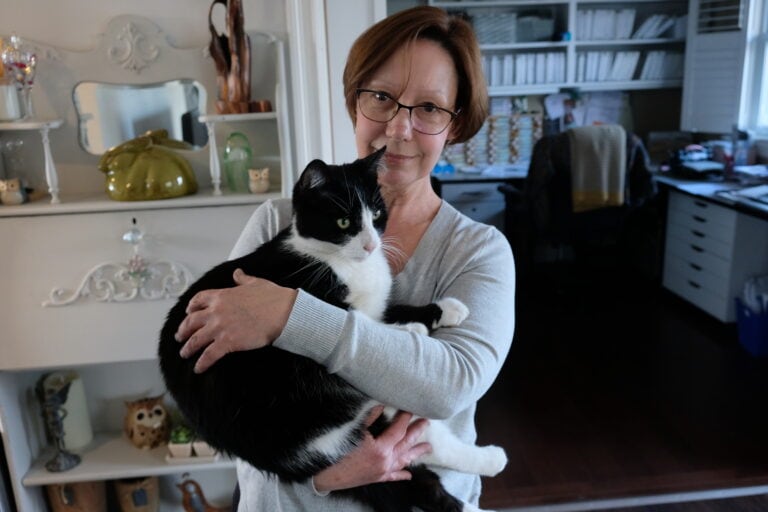Niagara’s chief medical officer of health says the lack of testing for COVID-19 likely means the number of cases is vastly underestimated.
Dr. Mustafa Hirji told a news conference Monday that as cases continue to surge, the public health department is being stretched to the limit once again and the number of hospitalizations is on the rise.
“Most countries in the world are seeing a very sharp, pretty vertical increase in cases really driven by the Omicron variant,” Hirji said, noting that in Ontario there’s been an alarming spike in cases.
“When we take a look at here in Ontario, you can absolutely see what's been going on for the last few weeks, and just the scale of how high that has been,” he said, highlighting a graph that shows the steepest growth curve since the beginning of the pandemic.
“We're all aware, of course, there's lots of struggles to actually get testing right now. And the province is now limiting testing. So we aren't actually even seeing the full number of cases out there and probably the true number is actually much higher than this.”
He said to get some sense of the numbers, testing has actually doubled, “and even though testing has doubled,” cases are about 11 or 12 times higher than they were in November 2021.
“That shows just how much more infection is going around, I think in terms of how many more people are testing positive,” he said.
The highly contagious Omicron variant has “completely overwhelmed” the previously leading Delta variant, he said.
“There's still a little bit going around, but it's really insignificant to what we're seeing with the Omicron variant now.”
Niagara’s trend is similar to the province, Hirji said, with a “very sharp upwards trend in cases.”
He said while Niagara’s cases aren’t showing quite as big an increase, he suspects the data is also skewed by limited testing.
Still, cases are far higher than any previous wave, he said.
The other part of the story, he said, is hospitalizations are increasing.
He said the province “tried optimistically a few weeks ago to put out a plan where they weren't going to worry so much about cases going up” and instead focus on hospitalizations.
That was clearly the wrong move, he said, despite vaccines proving effective at preventing hospitalizations.
“That was overly optimistic because if the vaccine is less effective (at preventing the spread) and more people becoming infected, this gap of people who are still going to be hospitalized despite the vaccine is going to be applied to a larger and larger number of people. And so those hospitalizations are going to start adding up.”
He said that’s exactly what we’ve seen as cases spike and he expects to see more over the next two week, as there’s typically a two-week lag in seeing upward trends in hospitalizations.
“I think the provincial announcement (Monday) is really a reflection that they've now realized that their thinking was overly optimistic and that hospitalizations are absolutely going to follow the cases going up.”
He said while ICU admissions aren’t seeing a big increase, it’s the same issue — as the cases rise, the more ICU admissions there will be, even with vaccines helping to reduce severe symptoms.
Niagara Health has “absolutely seen a big increase in hospitalizations,” he said, adding it’s getting close to what was seen during the peak of the third wave.
He said he’s been hearing chatter that it’s inevitable Omicron will spread to everyone but he calls that “very defeatist thinking.”
“We're seeing the true impact it's having on people who are being hospitalized. And so it's incumbent on us to try and do something to hopefully protect people's health,” he said, noting other countries like Germany, which saw the effects of Omicron before Canada, have actually managed to bring cases down somewhat.
While Germany is still seeing high case numbers, it’s “nowhere near as high as us and that's because they were aggressive early on about closing public spaces, limiting social interaction, especially heading into holidays and really making some of the hard choices of what was going to slow the spread of infection.”
He said the Ontario Science Table predicted more than three weeks ago that cases would skyrocket if no measures were taken to reduce the spread.
“If we go back three weeks, the Ontario Science table absolutely told us what we need to do. They said that if we did not have any additional measures in society, we would be” on a major upward spike.
“What they said is that if on Dec. 15 the province had put in place some circuit breaker measures to reduce people's social contacts by limiting interaction in public spaces, reducing gathering size and the like, we wouldn't have been able to stop cases going up but we could have blunted them — so instead of being way up here, we could have been down in the two, three, four thousand numbers of cases and having something much more manageable and having the opportunity to control our hospital admissions going up.”
The Science Table argued that if that had been done, we would have been able to do a better job of keeping schools and workplaces open.
“And what's important for that is, I think if we had done that we might have had a better chance of maybe protecting our economy. We've seen over the last few weeks that by avoiding putting restrictions, the pandemic basically has been causing harm to the economy instead,” he said.
“By being reactive and not being proactive about some of what we are seeing with the Omicron variant, we allowed the virus to disrupt our economy.”
Slowing the spread of infection would have bought time to “do the things that are going to make a difference, which is, of course, vaccination,” he said.
Hirji noted it will now be another couple of weeks before we start to see the positive impact of the prevention measures put in place this week.
“And unfortunately I do think we've had some lost time here to maybe blunt the impact of what this Omicron wave could do.”
Now people need to really consider what they are doing in their own lives, “because I think that is going to make a real difference.”
“If we avoid large gatherings and really actually I would argue avoid any kind of social contact with people where it's not truly essential, that's going to stop some of the virus.”
He said people need to continue to social distance and stay outdoors or in well ventilated spaces when around other people — and wear a “good quality” mask.
He said current actual case counts could be two to three times as many cases as are being reported, and possibly even higher.
Asked if public health had a sense of other things spreading around besides COVID, he said they do have a sense of other viruses. Right now parainfluenza is going around, as is rhinovirus and enterovirus.
“The biggest respiratory infection going around is still COVID-19 and the probability if you have something, is probably pretty high that you have COVID-19.”
He said since rapid tests are only about 75 to 80 per cent effective, “even if you test negative on a rapid test, I think it still could mean you have COVID-19.”
“That's why we always really emphasize PCR testing because that's much more accurate. And so if you have a symptoms, it's absolutely important that you do isolate, to make sure you're not spreading an infection to other people, even if you have that negative rapid test. And even if it turns out that you don't have COVID-19 and you have something else, the last thing you want to do is spread that infection to others and give them the scare that they have COVID-19.”
Hirji said PCR tests are still available for people with underlying medical conditions, but anyone else who shows symptoms of COVID should stay home and away from others.
“For others who don't have those high-risk conditions, it is just about isolating. You have symptoms, isolate from the rest of your family. Make sure you stay home and don't go out so you keep that infection just to yourself. Don't spread it to others,” he said.
“And if we do that we'll hopefully keep everybody else safe and keep ourselves safe.”



.jpg)







